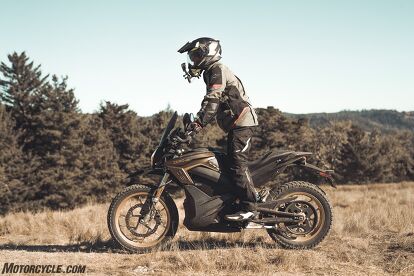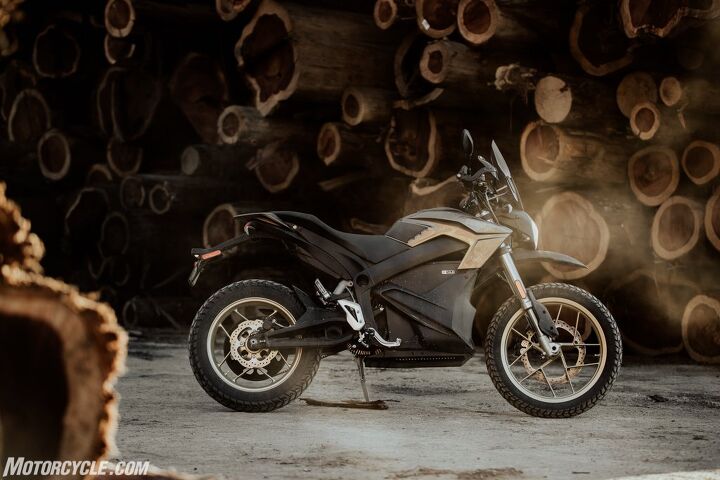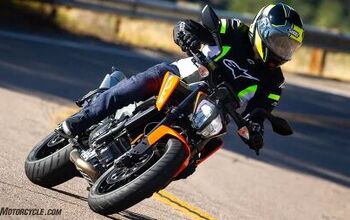2019 Zero DSR Review - First Ride

Funny thing about electric motorcycles: if you’re already an early adopter of the technology, the name Zero Motorcycles is all too familiar. If you still think electrics are as evil to the motorcycling landscape as Jar Jar Binks was to Star Wars… well, you might as well stop reading here. No matter where you stand, the staying power of Zero Motorcycles is hard to ignore. For over 13 years, Zero has been leading the way in electric motorcycle technology, and its staying power has seen it outlast all its competitors. For 2019, Zero is further staking its claim as the leader in electric motorcycle technology, perhaps bracing itself for the arrival of the Harley-Davidson Livewire in 2020.
2019 Zero DSR
| Engine | 18.75/20 |
| Suspension/Handling | 13.5/15 |
| Transmission/Clutch | 10/10 |
| Brakes | 7.75/10 |
| Instruments/Controls | 3.75/5 |
| Ergonomics/Comfort | 8.5/10 |
| Appearance/Quality | 8.5/10 |
| Desirability | 8.25/10 |
| Value | 7.75/10 |
| Overall Score | 86.75/100 |
For starters, the entire 2019 lineup sees some changes. There are bold new graphics, of course, with the street line getting darker colors and the dirt line covered in shades resembling sand, differentiating the two lines for their intended purpose. Improvements in battery chemistry and firmware technology have resulted in 35% more power and 8% higher top speed for the base model Zero S and DS with the ZF7.2 battery. For the up-spec S and DS with the ZF14.4 battery, the improved battery chemistry (same as the chemistry seen on the R models) means the 2019 gets 10% more capacity than last year.
With the advancement in battery technology comes the advancement (and hopefully standardization) of charging options. In 2018, Zero introduced the Charge Tank option, which fits a 6kW charging module to S/DS models, and accepts J1772 plugs typically seen at Level 2 charging stations. For 2019, this accessory is now backwards compatible to 2015 models and can be installed at the dealer level. With this option, owners of the ZF7.2 S or DS models can then refill their bikes to 95% within one hour.
The R&D team at Zero spends a lot of time studying customer feedback on real world usage of their motorcycles. It’s through this feedback they learned many customers leave their motorcycles plugged to the wall as they store them away for the winter. The logic seems sound, especially if you come from an internal combustion background: leave the battery on the trickle charger while in storage so it’ll be ready to go once the riding season is back.
Here’s the thing, according to Brian Wismann, VP of Product Development at Zero – Lithium-Ion batteries don’t like being at full states of charge for extended periods of time. Over the long-term this can degrade the batteries. Hence, the software team developed new patent pending firmware for the entire 2019 range called Long Term Storage Mode. If, after 30 days, the motorcycle has not gone through an ignition cycle (turning the key on), it will automatically discharge some of the battery to place it at roughly 60% full. There’s nothing the owner needs to do, and the bike will automatically wake up and revert to normal once they key is turned back on.
Maybe the best news for 2019 is a zero dollar increase in price for the new models over last year.
The new flagship
With experience also comes sales numbers, which show the on/off-road-capable Zero DSR slightly outselling its more street-biased SR sibling. As such, Zero has appointed the DSR the flagship of the lineup. From a mechanical standpoint, the DSR doesn’t change from the 2018 model Ryan reviewed earlier this year – and why should it change? The ZF14.4 battery is still mated to the Z-Force 75-7R, 775-amp motor, cranking out 116 lb-ft of torque. Showa long-travel suspension, Pirelli MT-60 tires, and J.Juan braking components all return for 2019 to try and harness all that torque.
Aesthetically, however, the DSR does get a few key things. First, it’s hard to ignore the Caldera Metallic paint job. The metallic-brown really pops in the sunlight, and when partnered with the gold wheels, the DSR really looks good. Further, Zero noticed its customers typically add the windscreen, tank grips, hand guards, and 12v power socket from the accessories catalog to their DSRs, so for 2019 all those accessories are now standard on the bike.
Much of our time with the DSR in the past has largely been focused on road riding. So, it shouldn’t be much of a surprise to learn the 2019 model behaves much the same way on the road. The massive amount of torque, available instantly, is still a rush to the senses. However, having the windscreen as standard equipment is a nice touch to divert some of the wind away from the rider’s chest and head. The handguards, too, are another nicety, as broken levers in a tipover is never fun and the little added wind protection over the hands on cold rides is also welcome.
We’ve mentioned before how, as a commuter, the S/DS platform is more than ready to tackle the daily grind. There’s more than enough juice in the ZF14.4 battery to handle most commutes, and whether you charge with the standard on-board charger or the 6kW Charge Tank accessory, you should be able to make it back home, too. Of course, being definitive is difficult with electrics, as riding habits and riding distances vary greatly. If you don’t get the Charge Tank accessory, having a cavernous, lockable storage space is especially convenient. The fact still remains, however, that long-distance touring is not what a Zero – or any electric, at least so far – is meant for.
Since we’ve already covered the DSR on the road, Zero gave us a small taste of what the DSR could do once the pavement ends. As part of a 53-mile ride on its recent introduction of the 2019 DSR, approximately 80% of it was through trails and dirt roads. None of the sections were particularly challenging (other than getting used to instant wheelspin in the dirt if you get greedy with the throttle), but that was the point; Zero’s new tagline is “Effortless Adventure,” with electric motorcycles opening up a new world of exploration for those who may not necessarily be interested in motorcycles otherwise.
If you simply want to get lost on two wheels and don’t want to be confined to paved roads, the DSR comes into its element. Without a clutch or gears, more of your attention goes towards the ride. And with the near silent operation of an electric motorcycle, there’s a serene quality that comes with exploring nature without disrupting it; animals hardly notice you’re there, and you can actually hear the birds chirping as you move along. To be clear, the DSR is completely out of its element if attacking Hard Enduro is the plan (the lack of a clutch makes it near impossible to pop the front wheel over obstacles), but a moderate dual sport ride certainly isn’t out of the question – that is what the D and S stand for, after all.
A skilled adventure rider I am not, but that is exactly why the DSR was a great companion during our ride. Nerves gave way to enjoyment as the motorcycle underneath me was so easy to ride. After 53 mixed miles, hooning it as often as I felt comfortable, the battery was still showing 44% charge. However, others on our ride – more accomplished ADV riders – had their battery levels down to the teens. If ever the phrase “Your mileage may vary” applies, this is it. At $16,495 before incentives and/or rebates, the Zero DSR is a great bike – for a specific kind of rider. It’ll still take a while before electrics truly become mainstream, but early adopters and technophiles fear not; Zero’s constant refinement of its products is a benefit to you.
In Gear

Helmet: Scorpion EXO-AT950 Neocon $289.95
- Jacket: Alpinestars Andes V2 Drystar Jacket $269.95
- Pants: Alpinestars Andes V2 Drystar Pants $229.95
- Gloves: Alpinestars SP-2 Leather Glove $139.95
Boots: Alpinestars SP-1 V1 Riding Shoe $199.95
2019 Zero DSR Specifications | |
|---|---|
| MSRP | $16,495 with Charge Tank: $19,390 |
| Motor Type | Z-Force 75-7R passively air-cooled, high efficiency, radial flux, interior permanent hi-temp magnet, brushless motor |
| Controller | High efficiency, 775 amp, 3-phase brushless controller with regenerative deceleration |
| Peak torque | 116 ft-lb (claimed) |
| Peak power | 70 hp at 3500 rpm (claimed) |
| Top speed (max) | adjustable to 102 mph (claimed) |
| Top speed (sustained) | 90 mph (claimed) |
| Power pack | Z-Force Li-Ion intelligent integrated |
| Max capacity | 14.4 kWh with Power Tank: 18.0 kWh |
| Nominal Capacity | 12.6 kWh with Power Tank:15.8 kWh |
| Charger Type | 1.3 kW, integrated |
| Charge Time (Standard) | 9.8 hours (100% charged) / 9.3 hours (95% charged) with Power Tank:12.1 hours (100% charged) / 11.6 hours (95% charged) All charge times claimed |
| With Charge Tank Option | 2.5 hours (100% charged) / 2.0 hours (95% charged) All charge times claimed |
| With One Accessory Charger | 5.7 hours (100% charged) / 5.2 hours (95% charged) with Power Tank: 7.0 hours (100% charged) / 6.5 hours (95% charged) All charge times claimed |
| With max accessory chargers | 2.8 hours (100% charged) / 2.3 hours (95% charged) with Power Tank: 3.3 hours (100% charged) / 2.8 hours (95% charged) All charge times claimed |
| Input | Standard 110 V or 220 V |
| Transmission | Clutchless direct drive |
| Final drive | 90T / 20T, Poly Chain HTD Carbon belt |
| Front suspension | Showa 41 mm inverted cartridge forks, with adjustable spring preload, compression and rebound damping, 7.00 inches of travel |
| Rear suspension | Showa 40 mm piston, piggy-back reservoir shock with adjustable spring preload, compression and rebound damping, 7.03 inches of travel |
| Front Brakes | Bosch Gen 9 ABS, J-Juan asymmetric dual piston floating caliper, 320 x 5 mm disc |
| Rear Brakes | Bosch Gen 9 ABS, J-Juan single piston floating caliper, 240 x 4.5 mm disc |
| Front Tire | Pirelli MT-60 100/90-19 |
| Rear Tire | Pirelli MT-60 130/80-17 |
| Front Wheel | 2.50 x 19 |
| Rear Wheel | 3.50 x 17 |
| Wheelbase | 56.2 in (1,427 mm) |
| Seat Height | 33.2 in (843 mm) |
| Rake | 26.5° |
| Trail | 4.6 in (117 mm) |
| Curb Weight | 419 lb (claimed) with Power Tank: 463 lb (claimed) |
| Equivalent Fuel Economy (City) | 435 MPGe (claimed) |
| Equivalent Fuel Economy (Highway) | 207 MPGe (claimed) |
| City Range | 163 miles (claimed) with Power Tank: 204 miles (claimed) |
| Highway Range At 55 mph | 98 miles (claimed) with Power Tank: 122 miles (claimed) |
| Combined City + Hwy at 55 mph | 122 miles (claimed) with Power Tank: 153 miles (claimed) |
| Highway Range At 70 mph | 78 miles (claimed) with Power Tank: 97 miles (claimed) |
| Combined City + Hwy at 70 mph | 105 miles (claimed) with Power Tank: 132 miles (claimed) |
| Warranty | 2 years |
| Power pack warranty | 5 years/unlimited miles |

Troy's been riding motorcycles and writing about them since 2006, getting his start at Rider Magazine. From there, he moved to Sport Rider Magazine before finally landing at Motorcycle.com in 2011. A lifelong gearhead who didn't fully immerse himself in motorcycles until his teenage years, Troy's interests have always been in technology, performance, and going fast. Naturally, racing was the perfect avenue to combine all three. Troy has been racing nearly as long as he's been riding and has competed at the AMA national level. He's also won multiple club races throughout the country, culminating in a Utah Sport Bike Association championship in 2011. He has been invited as a guest instructor for the Yamaha Champions Riding School, and when he's not out riding, he's either wrenching on bikes or watching MotoGP.
More by Troy Siahaan


















































































Comments
Join the conversation
In light of the recent Kaw 900 vs Honda CB1000 comparo, you guys should do something crazy like this Zero DSR vs the new FTR (as soon as you can get your hands on one). I bet that would be an interesting read, and since Alta bit the dust, there's no other eBikes to compare to. I'm sure it would certainly be fun.
One day someone will figure out how to make electric motorcycling practical and doable. That day has not yet arrived.